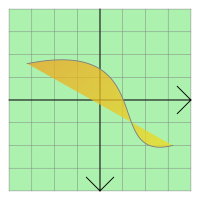
The QGraphicsPathItem class provides a path item that you can add to a QGraphicsScene. More...
| Header: | #include <QGraphicsPathItem> |
| CMake: | find_package(Qt6 REQUIRED COMPONENTS Widgets)target_link_libraries(mytarget PRIVATE Qt6::Widgets) |
| qmake: | QT += widgets |
| Inherits: | QAbstractGraphicsShapeItem |
| enum | anonymous { Type } |
| QGraphicsPathItem(QGraphicsItem *parent = nullptr) | |
| QGraphicsPathItem(const QPainterPath &path, QGraphicsItem *parent = nullptr) | |
| virtual | ~QGraphicsPathItem() |
| QPainterPath | path() const |
| void | setPath(const QPainterPath &path) |
| virtual QRectF | boundingRect() const override |
| virtual bool | contains(const QPointF &point) const override |
| virtual bool | isObscuredBy(const QGraphicsItem *item) const override |
| virtual QPainterPath | opaqueArea() const override |
| virtual void | paint(QPainter *painter, const QStyleOptionGraphicsItem *option, QWidget *widget = nullptr) override |
| virtual QPainterPath | shape() const override |
| virtual int | type() const override |
To set the item's path, pass a QPainterPath to QGraphicsPathItem's constructor, or call the setPath() function. The path() function returns the current path.

QGraphicsPathItem uses the path to provide a reasonable implementation of boundingRect(), shape(), and contains(). The paint() function draws the path using the item's associated pen and brush, which you can set by calling the setPen() and setBrush() functions.
See also QGraphicsRectItem, QGraphicsEllipseItem, QGraphicsPolygonItem, QGraphicsTextItem, QGraphicsLineItem, QGraphicsPixmapItem, and Graphics View Framework.
The value returned by the virtual type() function.
| Constant | Value | Description |
|---|---|---|
QGraphicsPathItem::Type |
2 |
A graphics path item |
[explicit] QGraphicsPathItem::QGraphicsPathItem(QGraphicsItem *parent = nullptr)Constructs a QGraphicsPath. parent is passed to QAbstractGraphicsShapeItem's constructor.
See also QGraphicsScene::addItem().
[explicit] QGraphicsPathItem::QGraphicsPathItem(const QPainterPath &path, QGraphicsItem *parent = nullptr)Constructs a QGraphicsPath item using path as the default path. parent is passed to QAbstractGraphicsShapeItem's constructor.
See also QGraphicsScene::addItem().
[virtual noexcept] QGraphicsPathItem::~QGraphicsPathItem()Destroys the QGraphicsPathItem.
[override virtual] QRectF QGraphicsPathItem::boundingRect() constReimplements: QGraphicsItem::boundingRect() const.
[override virtual] bool QGraphicsPathItem::contains(const QPointF &point) constReimplements: QGraphicsItem::contains(const QPointF &point) const.
[override virtual] bool QGraphicsPathItem::isObscuredBy(const QGraphicsItem *item) constReimplements: QAbstractGraphicsShapeItem::isObscuredBy(const QGraphicsItem *item) const.
[override virtual] QPainterPath QGraphicsPathItem::opaqueArea() constReimplements: QAbstractGraphicsShapeItem::opaqueArea() const.
[override virtual] void QGraphicsPathItem::paint(QPainter *painter, const QStyleOptionGraphicsItem *option, QWidget *widget = nullptr)Reimplements: QGraphicsItem::paint(QPainter *painter, const QStyleOptionGraphicsItem *option, QWidget *widget).
Returns the item's path as a QPainterPath. If no item has been set, an empty QPainterPath is returned.
See also setPath().
Sets the item's path to be the given path.
See also path().
[override virtual] QPainterPath QGraphicsPathItem::shape() constReimplements: QGraphicsItem::shape() const.
[override virtual] int QGraphicsPathItem::type() constReimplements: QGraphicsItem::type() const.